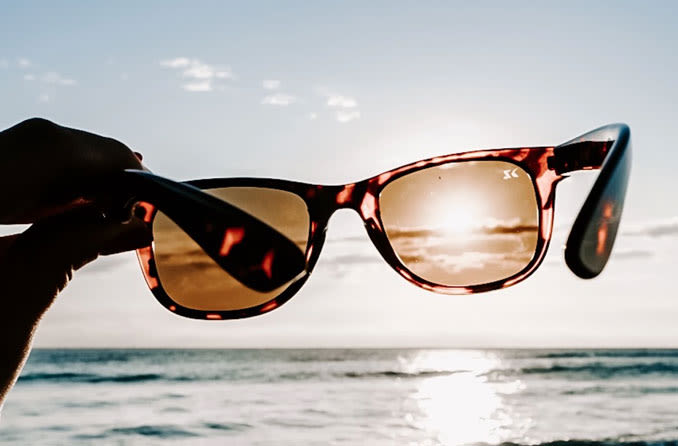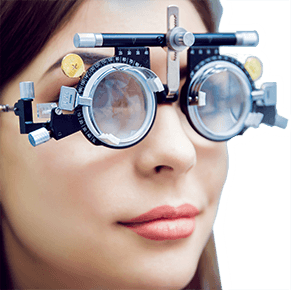Sunglasses: Frequently asked questions

If the sun doesn't bother my eyes, do I still need to wear sunglasses?
Yes. The sun emits damaging ultraviolet (UV) rays that can damage the eyes. And UV rays penetrate clouds, so you can get sun damage to your eyes even on overcast days.
What are UV rays?
Ultraviolet (UV) rays are high-energy, invisible light rays; sunlight is the main source of UV.
UV light is broken into three different types: UVA, UVB and UVC.
UVA has longer wavelengths and passes through glass easily; experts disagree about whether or not UVA damages the eyes.
UVB rays are the most dangerous, making sunglasses and sunscreen a must; they don't go through glass.
UVC rays do not reach the Earth because its atmosphere blocks them.
When do UV rays affect my eyes?
The sun's rays are strongest between 10 a.m. and 2 p.m., but that's not the only time UV rays can harm your eyes.
Glare and reflections can give you trouble too, so have your sunglasses ready if you'll be around snow, water or sand, or if you'll be driving (windshields are a big glare source).
Sunlamps, tanning beds, photosensitizing drugs, high altitudes and proximity to the equator also put you at greater risk of eye damage from UV radiation.
Do certain medical problems increase my risk for damage from UV rays?
Yes. People with cataracts (and those who have had cataract surgery), macular degeneration or retinal dystrophies should be extra careful.
What are my options to prevent UV damage to my eyes?
Wearing sunglasses that block 100 percent of UV rays is the best way to protect your eyes from the sun.
Some contact lenses provide UV protection, they don't cover your whole eye, so you still need sunglasses.
Also, you may want to consider wraparound sunglasses to prevent harmful UV rays from entering around the frame.
What are the different kinds of sunglass lenses available?
With so many lenses available, it's a good idea to ask your eye doctor for advice when choosing sunglasses. Different tints can help you see better in certain conditions, and your eye doctor or optician can help you choose sunglass tints that are best suited for your needs.
Polarized lenses. Sunglasses with polarized lenses generally provide greater comfort because they reduce glare from bright light reflecting off flat surfaces.
Anti-reflective coating. Sunglasses that have anti-reflecting (AR) coating applied to the back side of the lenses reduce glare by preventing light from reflecting off the back surface of your sunglasses.
Mirror-coated lenses limit the amount of light entering your eyes, so you're more comfortable.
Mirror coatings (also called flash coatings) are highly reflective coatings applied to the front surface of sunglass lenses to reduce the amount of light entering the eye. This makes them especially beneficial for activities in very bright conditions, such as snow skiing on a sunny day.
Gradient lenses are tinted from the top down, so that the top of the lens is darkest. These lenses are good for driving, because they shield your eyes from overhead sunlight and allow more light through the bottom half of the lens so you can see your dashboard clearly.
Double gradient refers to gradient lenses where the top and bottom portions of the lenses are dark and the middle of the lens has a lighter tint. Double gradient lenses are a great choice if you want sunglasses that aren't too dark but shield your eyes from bright overhead sunlight and light reflecting off sand, water and other reflective surfaces at your feet.
Photochromic lenses adjust their level of darkness based on the amount of UV light they're exposed to. Read more about photochromic lenses.
Multifocal sunglasses. Over age 40 and experiencing presbyopia? Not a problem. Virtually any type of sunglasses can be made with progressive lenses, bifocals or trifocals.
Do I need to worry about infrared rays?
Infrared (IR) rays are located just past the red portion of the visible light spectrum. Though infrared radiation produces heat (“heat lamps” that keep food warm in restaurants emit IR rays), most experts agree that the sun's infrared radiation does not pose danger to the eyes.
Which sunglass lens color is best?
Lens color is a personal choice and doesn't affect how well sunglass lenses protect your eyes from UV light. Gray and brown are popular because they distort color perception the least.
Athletes often prefer other tints for their contrast-enhancing properties. For example, yellow lenses are popular with skiers and target shooters because they work well in low light, reduce haze and increase contrast for a sharper image.
Are impact-resistant lenses necessary?
For comfort and safety, choose sunglass lenses that are both impact resistant and scratch resistant. Polycarbonate lenses usually are the best choice for sunglasses because they are lightweight and significantly more impact resistant than lenses made of glass or other materials.
Do darker sunglass lenses provide more UV protection than lighter lens tints?
Darker sunglasses decrease the amount of visible light that passes through the lenses compared with lighter lens tints, but they don't necessarily provide greater protection from invisible UV rays. For adequate sun protection, make sure your sunglasses block 100 percent UV, regardless of the color or darkness of the lenses.
Do children need sunglasses?
Children's sunglasses are essential. Children are at particular risk because they're in the sun much more than adults, and their eyes are more sensitive as well. UV damage is cumulative over a person's lifetime, which means you should begin protecting your child's eyes as soon as possible.
I wear eyeglasses. What options are available to me?
Photochromic lenses are an excellent choice for sun protection outdoors if you need corrective lenses. They provide 100 percent of the sun’s UV rays and darken automatically in sunlight. In many cases, photochromic lenses can eliminate your need for a separate pair of prescription sunglasses.
Can sunglasses designed for specific sports really make a difference?
Yes. Sports eyewear in general tends to be safer than regular sunglasses because the lenses and frames are made of special materials that are unlikely to shatter if struck and can give you the benefits of both sunglasses and protective eyewear.
Also, certain tints can enhance your vision for certain sports. For example, amber and brown lenses are popular with golfers because they enhance the contrast between the ball and fairways, greens and the sky.
Page published on Monday, December 30, 2019






